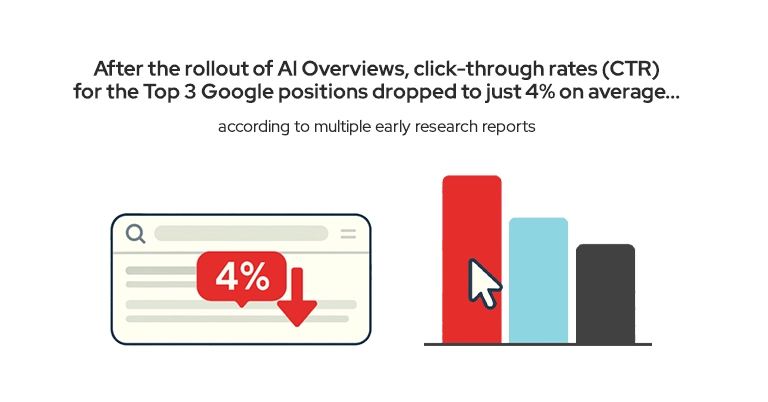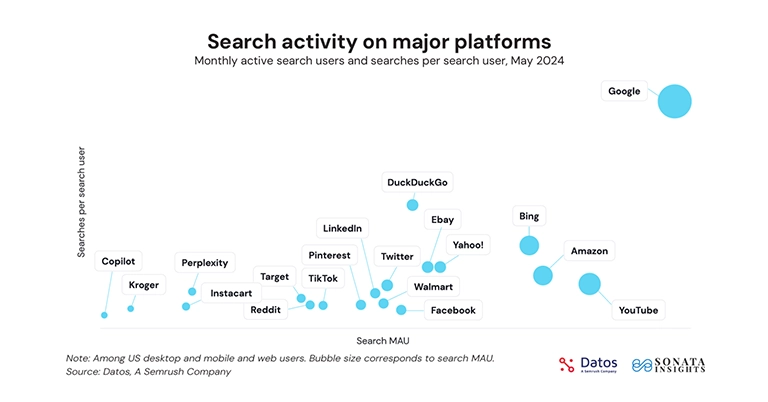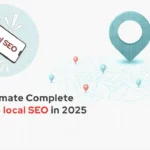Table of Contents
ToggleIn 2025, ranking in Google’s AI Overviews is a must for SEO success. This guide has all the info on how to optimize your content for generative search and in AI powered results step by step.
As Google’s AI Overviews appear in more search results, ranking competition has moved beyond traditional blue links. According to an Ahrefs study, this shift has led to a 34.5% reduction in clicks. The upside, however, is that AI Overviews can pull and cite information from any source—regardless of your page’s ranking or position.

Understand AI Overviews and the New Search Way
When Google started its AI Overviews feature, they started observing how users interact with search results. Traditional SEO is not enough to maintain top positions. Instead, we need to think on how to rank in AI Overviews. You’re optimizing a blog post or building a full content strategy. This AI-powered search environment in 2025 is the one way to go on how users engage with it.
What Are Google AI Overviews?

Google AI Overviews are concise, AI-generated summaries displayed at the top of Google Search results. These overviews provide users direct answers from various sources that Google’s AI feels reliable, authoritative and relevant. Appearing in AI Overview means your content is dense in knowledge, it’s not just SEO optimized, it’s useful enough by Google’s AI systems to summarize search queries.
These overviews have links, source mentions and embedded tools or answers. They improve the search experience by answering queries instantly. Your chances of being featured in AI Overviews depends not only on keywords but also on how well your content is in search intent and AI comprehension.
Read More: Best Digital Marketing Agency in Chittagong
Why Ranking in AI Overviews is a Fact?
Featured in an AI Overview has an advantage similar to a featured snippet. You’re not just listed, you’re summarized by Google’s generative AI, placing your site on organic search results. This visibility in AI Overviews can significantly boost organic traffic, CTR and authority.
More importantly, as AI-driven search becomes the default tool in 2025, users are more & more skipping ranked sites on top 20 or even top 10. If your content isn’t optimized for AI Overviews, it may never be seen by visitors no matter how good your SEO was in the past.
The Shift from Traditional SEO to AI-Powered Optimization

In traditional SEO, you focused on keywords, backlinks and page speed. These are still relevant, AI Overviews prioritize different factors. Like,
- Contextual relevance over simple keyword matching
- Semantic depth and topical completeness
- Structured content that’s easy for AI models to parse
- Search intent alignment to satisfy user needs
Google’s Search Generative Experience (SGE) is designed to work with more complex queries. If your content doesn’t support multi layered answers or lacks AI-friendly structure, it’ll not appear in these new results.
How AI Tools and Models Influence Ranking?
Google’s AI models like Gemini are trained for synthesizing, evaluating and summarizing content based on user intent. This means AI is not just crawling. Your content must now pass through a higher semantic filter, easy readability is not enough, it must be understandable to AI.
Using tools like Google Search Console can help you monitor impressions, click throughs and your content appears in these AI formats. You must focus on content that answers, content that’s optimized for AI, and follow Google’s AI Overview mechanics.
Factors That Help You Rank in AI Overviews
Here are early signals and tactics that may increase your chances of appearing in AI-powered search,
- Structured formatting: Use headers, lists and semantic HTML.
- Topic authority: Provide semantic coverage of your niche.
- Clear answers: Focus on queries and direct explanations.
- Semantic optimization: Use NLP-based strategies, not keyword stuffing.
- Content freshness: Update regularly with relevant 2025 context.
- Technical SEO: Site performance, crawlability and schema markup.
These strategies will help you rank for AI Overviews and also improve your overall performance in Google Search.
How to Optimize Your Content for Google AI Overviews?
To appear in Google’s AI Overviews, your content must do more than rank well in traditional searchmit must be optimized for AI comprehension, structured to deliver value fast and written as AI systems. This means approach more than keywords and backlinks into your strategy for AI-powered search behavior in 2025.
AI Overviews depends on Google’s generative models to extract high-value summaries from your content. Therefore, formatting is a must, because AI must “read” and summarize, not just index.
To support this, you need to:
- Use hierarchical headers (H2s, H3s) that mirror how users ask questions.
- Answer specific queries early, preferably within the first 100 words of a section.
- Add lists, tables and bullet points to enhance scan-ability.
- Implement FAQ sections targeting long tail queries.
- Use schema markup to help AI understand your content structure.
Google’s AI Overview result is not anything to rank. Your content must be written that way so that it;s sharing a clear, concise and authoritative answer.
Optimize Your Content Using AI SEO Strategies
Let’s shift from structure to substance. To rank in AI Overviews, your content must be context rich and focused on search intent rather than just volume. The right SEO strategies are,
Use Semantically Related Keywords
AI models understand concepts, not just exact terms. Use tools like Google’s NLP API or competitor research to identify related keywords, phrases and questions users search around your topic.
Target Search Queries Directly
Add subheadings in the form of questions (e.g. How does Google rank AI content?) and answer them immediately below.
Optimize for Generative AI
Create content that answers fully and clearly. Generative AI models like those because they use it to train Google’s AI mode. Avoid fluff, vague language or keyword stuffing.
Update Content for 2025
Make sure your examples, tools and references are updated. Google’s algorithms prefer content that are on current trends, especially for AI overviews in 2025.
Focus on Query Intent, Not Just Keywords
Many creators make the mistake of focusing only on search engine results rather than user query intent. But AI understands context and nuance. For example, if someone searches for “best ways to optimize content for an AI search engine,” they’re not looking for SEO advice, they want AI specific tips and steps.
To do this, we need to do,
- Analyze intent behind keywords before writing.
- Match answers to likely search scenarios, not just terms.
- Provide real, usable examples for every solution offered.
Use AI Tools to Improve Optimization
Modern AI tools can help you optimize content for Google AI Overviews. Like,
- Content scoring tools like Clearscope or Surfer SEO (for NLP coverage)
- Google Search Console (to monitor organic performance)
- AI writing assistants (for refining tone and structure)
These tools don’t replace good contentm they make it easier to create content that AI understands.
What Makes Content AI Friendly?
To make your pages more likely to appear in AI-driven search results:
- Use specific, evidence based claims with sources
- Maintain high topical relevance
- Make it easier for AI to identify what you’re trying to say
- Avoid jargon unless your audience expects it
The goal is to build content for AI overviews, not just human readers. But this doesn’t mean robotic language, it means clarity, structure and depth.
Example of Optimized Section for AI Overviews
To appear in AI Overviews, create a clear answer to common SEO related queries within your content. Use structured headings, answer in 2-3 sentences and link to perfect sites for backlink. Add relevant keyword like seo strategies, rank in google and search intent.
This helps AI pull contextually accurate summaries and gives you a better shot at landing featured in AI overviews sections.
Google’s Ecosystem & Strategy for AI Overviews
By now, you understand the structure and techniques needed to create content that’s optimized for AI. But content isn’t everything, it’s also about how you monitor performance, adapt to AI behavior and integrate Google’s ecosystem into your SEO. In this section, we’ll explore tools, data and strategies that will help in Google’s AI powered search in 2025.

Using Google Search Console to Track AI Overview
Google Search Console is the best tool as this is a tool from Google. AI Overview performance isn’t fully broken out in all analytics platforms, Google has been slowly rolling out indicators to show whether a URL appeared in AI or not.
Monitor impressions and clicks: If you see higher impressions without corresponding clicks, your content may be surfaced in AI Overviews, but not clicked.
Track queries triggering AI snippets: Look at your top performing pages and match them with rising search intent queries.
Identify drops in organic traffic: A sudden dip may indicate your page was replaced in AI Overviews by another source.
Although full transparency in AI Overviews appearance is still there, Google’s reporting tools give enough data as performance changes with the rise of AI driven search.
How Google Analytics Supports AI Optimization?
Google Analytics works with Search Console by giving you behavioral insights,
Track user flow: Are users spending more or less time on your content after it comes in AI results?
Monitor engagement metrics: High bounce rates on pages referenced in AI means users are getting their answers before visiting.
Segment organic traffic by landing page: This helps identify which types of content are mostly featured.
Research on data with Google’s AI Overview performance and you’ll build a clearer picture of what’s working and what needs re-optimization.
Example on How Content Gets Featured in AI Overviews
Let’s share an example of content featured in an AI Overview for the search query,
“What is the best way to structure SEO content for AI search engines?”
This AI Overview had the following characteristics,
- A clear H2: “How to Structure SEO Content for AI-Powered Search”
- A paragraph answering the question in under 70 words
- A follow-up section with bullet points offering examples
- Natural use of related terms like “optimize for ai overviews”, “ai search results”, “content strategy” and “seo strategies”
The site didn’t rank #1 in organic results but still got featured in an AI Overview. AI Overviews prioritize value and clarity over rank. You don’t have to be in the top 3, your content just has to make it easier for AI to extract data.
Organize Your Content Strategy for AI Overviews in 2025
Google’s AI Overview system has changed how we think about SEO strategies. Instead of just working with keywords, we need to also work with:
1. Creating AI-Compatible Clusters
Instead of single topic articles, develop content clusters centered on core topics. AI loves content that works with topical authority.
Example: If your core topic is AI content optimization, write related topics with semantic search, query intent, technical SEO for AI and generative AI tools.
2. Structuring to Support AI Summarization
Your headers, FAQs and examples should all help AI models break your content into meaningful part. This means:
- Structuring subheadings as questions
- Using short, direct answers with definitions
- Including examples, analogies and citations
3. Matching the AI Search Experience
Search Generative Experience (SGE) replicates a conversation. If your content mimics that style, concise, helpful and progressive. Think like a tutor, not a textbook.
4. Enhancing Organic Visibility
Even if your content isn’t featured in AI Overviews immediately, all these optimizations also benefit traditional SEO:
- You’ll show up more in organic search results
- Google’s AI systems may re-evaluate you for future inclusion
- Search engines understand your content better over time
The Impact of AI Overviews on Organic Results
The AI Overviews impact on traditional traffic can’t be ignored. In some cases, they reduce clicks to organic links. But in many others, they increase visibility for well-optimized pages even those that previously ranked on page two.
Why? Because:
- AI Overviews pull from diverse sources, not just top-ranking sites
- Featured content often links back to the source, driving targeted clicks
- Users trust content that’s featured in an AI Overview, enhancing authority
So while AI overviews often change the click-through flow, they also offer new opportunities to rank.
Building Long Term Growth in Google’s AI Search
Success in 2025 depends on your ability to create content for AI overviews without sacrificing user experience. It’s not about gaming the system it’s about:
- Understanding how AI reads and evaluates
- Providing comprehensive, trustworthy answers
- Making your content easier for AI to summarize
This is the future of search engine optimization, a mix of traditional SEO foundations and AI-friendly content engineering.
Final Optimization Steps
How to rank in AI Overviews requires more than just optimizing a few pages, it needs a full shift on SEO, search engines and the future of content. In this final part, we’ll highlight critical do’s and don’ts and answer questions to help you succeed in Google’s AI-powered search landscape in 2025.
Content for Google AI
You’ve built a content framework that is clear, structured and centered on search intent. Now, let’s lock in the details that push you to being featured in an AI Overview.
- Optimize for Featured-Like Clarity
Treat each H2 or H3 like an opportunity to be quoted by the AI:
- Use headers like: How to optimize your content for AI search results
- Follow it with a two- to three-sentence answer
- Provide follow-up with supporting bullet points or examples
This structure is highly favored by AI models because it shows how they break down search queries and synthesize answers.
- Optimize Your Content for AI Mode
In AI mode, search engines aren’t matching terms, they match intent and context. When creating content for AI overviews, ensure your sections:
- Address questions users genuinely ask
- Use NLP-rich keywords like ai search engine, generative ai and ai tools
- Reflect the language and structure of search generative experience
- Increase Your Visibility in AI Overviews
Remember: You can rank in AI search results, if you’re not in the top 10 traditional results. To boost visibility in AI Overviews here are the tips,
- Link internally between semantically related content
- Use Google Search Console to monitor emerging queries
- Re-optimize pages based on behavioral data from Google Analytics
Top of search results can work in multiple formats like, text, snippets, overviews, so be ready for all.
Don’t Forget These Optimization Works
- Query Relevance: Match search questions directly with headers & answers
- Keyword Clarity: Naturally use terms like rank in google ai overviews, ai overview
- Technical SEO: Schema markup, crawlability, mobile-friendliness
- Content Strategy: Cluster topics around central themes for topical authority
- Search Engine Signals: Track AI-driven queries, CTR, bounce rate
Don’t just create content, create content that answers directly to any queries. That’s what Google’s AI-powered search values are.
Ranking in Google’s AI Overviews in 2025 requires content that is structured, smart and semantically rich. The future of SEO is here and it’s AI-driven.
FAQs
How often are AI Overviews updated in Google Search?
Google’s AI Overviews are updated within a period of time, sometimes daily, depending on search trends, user intent and newly indexed content. High quality, fresh and structured content has a better chance of being included regularly in AI-driven search results.
Can small websites get featured in AI Overviews?
Yes. Traditional search engine rankings that favor domain authority, AI Overviews focus on content quality, clarity and relevance. Even small sites can appear if their content answers the query better than top ranking competitors.
Is traditional SEO still relevant in AI Overviews?
Absolutely. While traditional SEO won’t get you into an AI Overview, then technical SEO, link building and intent form the base layer. They’re now complemented by AI-centric strategies.
Which tools help you rank in AI-powered search?
Some helpful tools include:
- Google Search Console, to track impressions & performance
- Surfer SEO / Clearscope, to cover semantic keywords
- Google Analytics, to monitor engagement & behavior
- AI tools, like ChatGPT or Gemini for rewriting & formatting
Use these to make your content for AI overviews smarter and more engaging with how search engines understand data.
What role does content structure play in AI Overview rankings?
A massive one. Google’s AI systems extract answers from well-structured pages using H2s, question based headings, short summaries and bulleted data. A well organized page makes it easier for AI to identify the best overview result.
Does being featured in an AI Overview affect organic traffic?
It can go both ways. Some users find what they need in the overview and don’t click. But when your page is linked in the AI Overview, you’re seen as an authority, which can boost visibility, trust and overall search ranking.
Alif Meherab is a digital strategist and front-end developer specializing in netnographic communications, brand positioning, and neuromarketing tactics. With expertise in UI design, digital marketing strategy, and promotional storytelling, Alif helps brands connect with audiences through impactful copy, engaging visuals, and retention-driven social media campaigns.
- Alif Meherab
- Alif Meherab
- Alif Meherab



